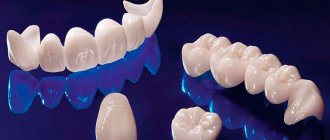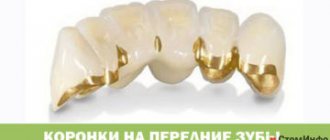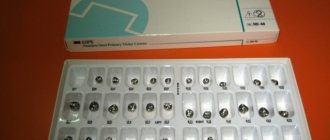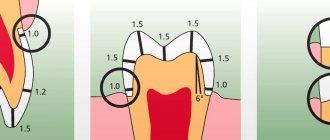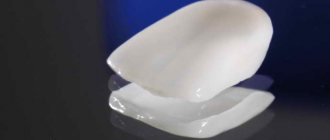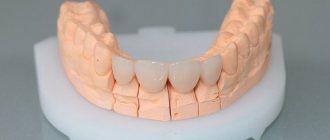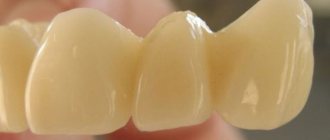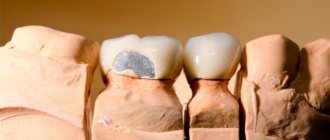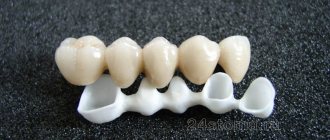Use of gold in dentistry
There are two ways to make such crowns: stamped and cast. For stamped ones, special blanks are made. Cast products are cast from gold using wax casts. They do not require any adjustment during installation because they already have a certain size. Cast products are more expensive than stamped ones, but in this case the tooth has to be ground much harder.
Dental crowns from 850 to 900 gold are used. In order for the prosthesis to be stronger, it is made not from pure gold, but with the addition of silver and copper.
Indications and contraindications
There are both indications and contraindications for the installation of such dental products. First of all, these are situations where it is possible to install only gold prostheses. Such cases include:
- the need to strengthen teeth;
- improving the aesthetic appearance of the row;
- restoration of teeth actively involved in the chewing process;
- the need to restore the previous shape of the tooth;
- Having a strong bite or teeth grinding habit.
There are a number of contraindications for installing gold crowns. It is not recommended to install them:
- under the age of 16;
- for diseases associated with the psyche;
- during pregnancy;
- with periodontitis.
If you are thinking about installing gold crowns to decorate your teeth, then stop. There is an easier way to decorate your teeth - grills:
How to care
You should clean your gold crowns twice a day with a regular brush and toothpaste. To prevent the formation of tartar, the development of caries and inflammation of the gums, it is recommended to clean the junction of the crown with soft tissues using floss (dental floss). It is forbidden to bite nails, hard food, nuts or seeds with gold crowns.
The total cost of a gold unit depends on the shape, weight, alloy from which the crown is made, as well as the prices for prosthetics in a particular clinic
Tooth preparation and crown installation
Preparation and installation of prostheses requires certain stages. For this process you need:
- Prepare the tooth. If caries is present, carry out special treatment and replace the filling.
- Before the procedure itself, the tooth should be numbed.
- The tooth is ground down on each side and adjusted to the thickness of the crown. It is given the required shape. Be sure to leave small ledges to secure the crown.
- The next step is taking impressions of the upper and lower dentition.
- A wax model is made using a plaster cast.
- The gold prototype is cast.
The patient is given a temporary crown, which remains in place until the gold one is made, since this process takes a certain time. It will protect the tooth from damage and destruction. After making a permanent crown, it is installed as follows:
- First, it is tried on and, if necessary, adjusted to the tooth.
- Before fixing it, check how tightly it fits and whether the teeth and the crown fit together correctly.
- The last stage is fixation with special dental cement.
Rehabilitation period
If the work is performed at the proper level, there will be no need for special adaptation to gold microprostheses, since from the point of view of sensations they do not stand out in the dentition and are almost immediately able to withstand a full chewing load.
You will have to refrain from eating and drinking for several hours after installation. This need is determined by the materials used to secure the prosthesis.
In order to increase the service life and comfortable adaptation to the crown, it is not recommended to eat solid food.
Possible unpleasant consequences of installing crowns:
- Increased tooth sensitivity . Failure to remove the nerve under the treated tooth in advance increases the risk of a reaction to cold, hot, sour, etc. It is necessary for the dentist to prescribe a special toothpaste.
- A crown that is too high can cause pain when chewing . In such a situation, a second visit to the dentist will be required.
- When performing parafunction of the masticatory muscles on a patient, you will need to use a night guard.
- Washing out the cement on which the microprosthesis was fixed . This increases the risk of crown mobility, or its complete destruction, and infections penetrating under the structure. A second visit to a specialist is required to secure the crown more firmly.
Advantages and disadvantages
Gold dentures have their pros and cons. Before deciding to install a gold crown on a tooth, you should study their advantages and disadvantages. The positive points include:
- beneficial effect of precious metal on teeth and microflora in the oral cavity;
- inertness of the metal in relation to the components of saliva and food;
- completely hypoallergenic;
- their ability to withstand any chewing load;
- quite a long lifespan, the durability of gold crowns with proper care can be extended to almost 15 years;
- protecting the tooth from caries, as gold has anti-inflammatory properties;
- inability to cause a destructive effect on the teeth in the opposite row at the junction of the jaws.
In the first days of installation, patients usually feel discomfort, which is not a disadvantage of the procedure. After a short period of time this condition will pass. The disadvantages of gold-plated teeth are:
- the softness of gold and gradual abrasion over time;
- very expensive installation, because gold itself is a precious metal;
- unaesthetic appearance of the front teeth.
A tooth with a crown and a living nerve becomes sensitive and reacts painfully to hot or cold food or drink, but this is a temporary phenomenon.
Such crowns are reused if they are in good condition, and they can also be sold or melted down.
Advantages
Gold crowns have many advantages compared to other materials used for prosthetics:
- full compatibility with soft tissues of the oral cavity;
- the absence of any harmful additives in the alloy - as a result, there is no risk of an allergic reaction, irritation and other unpleasant manifestations on the oral mucosa;
- high strength – for the manufacture of crowns, gold of the highest standard is used, which is resistant to any damage;
- due to the softness of the alloy, antagonist teeth are not injured;
- After prosthetics, almost complete “fusion” of the natural unit and the gold crown occurs.
DETAILS: Restoration of anterior teeth with filling material: methods and technology
Patient reviews
And I like gold teeth. This has always been considered an indicator of financial importance. I still have dentures from my grandmother; I can take them to a pawnshop. You just need to find out how to clean gold crowns from your teeth and check what kind of gold dental crowns are made of. But I wouldn’t put one on myself, because it’s unfashionable now.
Sergey, St. Petersburg
I am against gold teeth. They look unnatural. But last year I knocked out my front tooth during training. I went to the dental clinic and, as it turned out, not all dentures suit me. The dentist recommended inserting a gold tooth. I doubted it very much, but there were no other options for me. It turns out that they are placed for medical reasons. Especially if there are problems with the kidneys or liver.
In addition, gold dentures last about 15 years. You just need to take proper care of them. I asked what type of dental crowns are used. The doctor explained that gold teeth are of high standard and joked that this is a good investment.
Maxim, Nizhny Novgorod
Several years ago, on the recommendation of a doctor, I had gold teeth installed. It’s good that they are not front, so they don’t interfere with the aesthetics of the look. Gold interacts well with gums and does not cause discoloration. I didn't have any allergic reaction. I know that such teeth do not cause any negative reaction in the body. They are placed if the patient has significant stomach problems. Coated teeth often cause various complications.
However, I think that from time to time it is necessary to take pictures to make sure that everything is in order with the teeth.
It's just for insurance. And so they will serve for at least 10 years, or even more. Marina, Orel
How to clean dentures at home: folk remedies
There are other ways to clean dentures at home, besides expensive medications. These are proven folk remedies. All of them will come to your aid if you don’t have any medications or other cleaning compounds at hand.
Cleaning dentures with folk remedies includes the following popular methods:
- Using vinegar. It is necessary to immerse the dental structure in a glass of vinegar and keep it there for 2 hours. But using this cleaning option is often not recommended, because vinegar has a very detrimental effect on the strength of the denture.
- Tooth powder and lemon. Take ¼ lemon, squeeze out the juice and combine with tooth powder. Distribute the mixture onto the denture and hold for 20 minutes. After this, clean the product with the same powder. Rinse thoroughly under running water.
- You can add a little lemon juice or mouthwash to the water where dentures are stored. This will protect the structure from plaque and ensure their cleanliness for a long time.
- Alkaline sodium hypochloride. Cleaning removable dentures at home using this product will keep the product white and stain-free. Alkaline sodium hypochloride effectively removes stains and reduces the possibility of bacterial growth on dentures. This is achieved as a result of oxidation, due to which the bond of the colored molecule is broken and it becomes colorless. To prepare the solution, you need to take a closed container, add 10 ml of regular white and 200 ml of water. Place the dental structure there for 5 minutes. Rinse thoroughly with plain water. You can use another solution, for which you take 20 ml of the cleaning product Dentural and dissolve it in a glass of water. Dentures should remain in the solution for about 10 minutes. Afterwards, be sure to treat with plain water.
- Microwave. If dental structures do not have metal inserts, then you can put them in the microwave. To perform the procedure, you need to place the product in the cleaning solution and turn on the microwave for 2 minutes. After the specified time, harmful microorganisms will die, and no dirt or food debris will remain on the dental structure.
Installing dentures does not mean that you need to forget about them completely. They, just like your teeth, require careful care. Simple methods that are available to absolutely everyone at home will help preserve the whiteness of the structure and extend its service life. In addition to daily treatment with a special solution, it is necessary to use special pastes and tablets that have an antibacterial effect.
To cope with the problem without investing significant funds, you can try using folk recipes at home. Experience shows that the methods described below are very effective.
Option 1.
- Take table vinegar and pour it into a glass.
- Place the dentures in a glass for 2 hours.
- My design.
We suggest you read: Unpleasant smell from under the crown: what to do, how to eliminate it
The method is considered quite good, but has a drawback: it negatively affects the strength of the product.
So let's try to do things a little differently.
Option 2.
- Fill the cup with a mixture consisting of vinegar and clean water in equal proportions.
- We lower the prosthesis into the container.
- We are waiting for the night.
- In the morning, apply toothpaste to the toothbrush and clean all elements of the structure.
Advice: pour warm water, but not hot, otherwise the prosthesis may become deformed.
Option 3.
- We buy a lemon.
- Squeeze the juice out of it into half a teaspoon of toothpaste.
- Apply the mixture to your teeth.
- Leave for 20 minutes.
- Rinse the denture with clean water.
- Additionally, we treat the denture with a brush without paste to remove all remaining lemon juice.
The method can be used once a month. It is not necessary more often, after all, lemon juice is a rather aggressive environment, and not only for bacteria.
Option 4.
If your prosthesis does not have metal parts, use the Microwave technique.
- Place your teeth in the cleaning solution.
- Place the container in the microwave and turn it on for a minute.
- Turn off the device and remove the prosthesis.
After rinsing the product with water, put it on.
